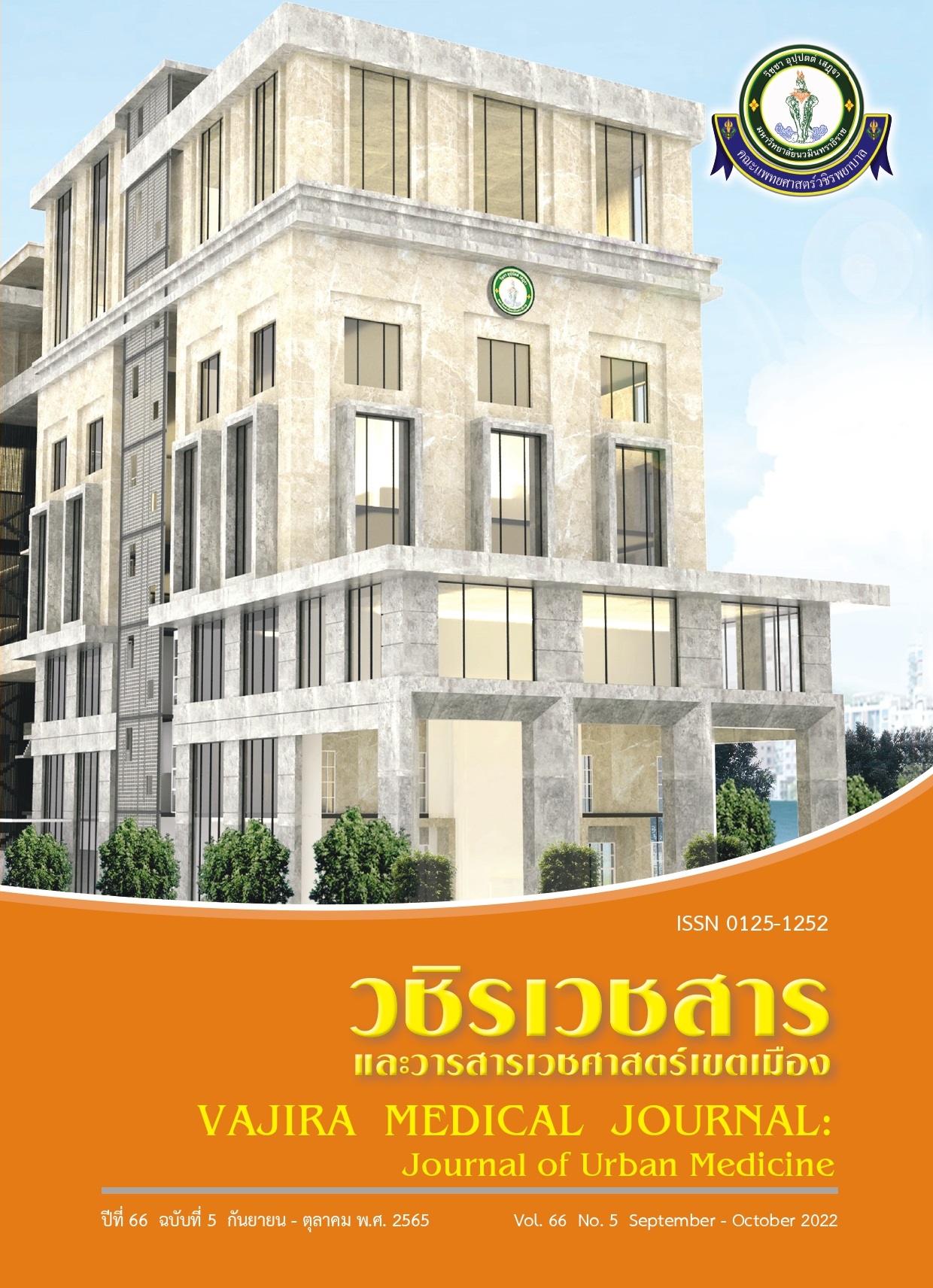Blood Loss-Related Functional Outcome in Post-Operative Total Knee Arthroplasty: Prospective Cohort Study
Main Article Content
Abstract
Objective: Current blood management programs for knee arthroplasty recommend avoiding blood transfusions and setting criteria for hemoglobin (Hb) < 7 g/dl or < 8 g/dl inpatients who have cardiac diseases or specific situations that do not concern the pre-operative HB level. This cutoff is safe for hemodynamically stable patients and those without cardiovascular complications. However, no study has shown the result of functional outcome, which is the primary objective of total knee arthroplasty (TKA).
Methods: We conduct an 18-month prospective cohort study on patients diagnosed with primary OA knee and indicated for surgical treatment with total knee arthroplasty at a single medical school hospital. Patients were divided into two groups of HB loss <20% or ≥20%. Timed up and go information was collected and compared at pre-operative period and post operative day 1, 2, 3 and 14.
Results: A total of 154 patients were analyzed. No significant different in patient characteristics was found between the Hb loss <20% group (group 1, n=120) and HB loss ≥20% group (group 2, n=34). Comparison of mean TUG between the two groups found no significant difference on post-operative day 1 (81.34 ± 20.09 and 84.99 ± 25.59 (P=0.45)), 2 (56.85 ± 11.12 and 59.06 ± 13.67 (P=0.39)), 3 (44.14 ± 8.20 and 45.66 ± 9.19 (P=0.35)) and 14 (31.92 ± 6.02 and 34.04 ± 5.99 (P=0.07)).
Conclusion: No significant difference in physical outcomes was found between the two groups. Current blood transfusion criteria after total knee arthroplasty can be used without concern about the physical outcome at the early post-operative period.
Downloads
Article Details

This work is licensed under a Creative Commons Attribution-NonCommercial-NoDerivatives 4.0 International License.
References
Singh JA. Epidemiology of knee and hip arthroplasty: a systematic review. Open Orthop J 2011;5:80-5.
Davies AJ, Roberts DE. A complication following a total knee arthroplasty. Br J Radiol 1999; 72(855):317-8.
Prasad N, Padmanabhan V, Mullaji A. Blood loss in total knee arthroplasty: an analysis of risk factors. Int Orthop 2007;31(1):39-44.
Song K, Pan P, Yao Y, Jiang T, Jiang Q. The incidence and risk factors for allogenic blood transfusion in total knee and hip arthroplasty. J Orthop Surg Res 2019; 14(1):273.
Goodnough LT, Shuck JM. Risks, options, and informed consent for blood transfusion in elective surgery. Am J Surg 1990;159(6):602-9.
Bierbaum BE, Callaghan JJ, Galante JO, Rubash HE, Tooms RE, Welch RB. An analysis of blood management in patients having a total hip or knee arthroplasty. J Bone Joint Surg Am 1999;81(1):2-10.
Carling MS, Jeppsson A, Eriksson BI, Brisby H. Transfusions and blood loss in total hip and knee arthroplasty: a prospective observational study. J Orthop Surg Res 2015;10:48.
Spahn DR. Anemia and patient blood management in hip and knee surgery: a systematic review of the literature. Anesthesiology 2010;113(2):482-95.
Loftus TJ, Spratling L, Stone BA, Xiao L, Jacofsky DJ. A patient blood management program in prosthetic joint arthroplasty decreases blood use and improves outcomes. J Arthroplasty 2016;31(1):11-4.
Majeed H, Bishnol A, Yallupa S, Howard P. Blood transfusion after total knee arthroplasty; comparison of drainage versus non-drainage. J Hematol Thromb Dis 2013;1(3):1-3.
Tavares Cardozo R, Fidelis de Souza Junior E, Campoli Alves W, Barbi Filho F. Total knee arthroplasty: indication of blood transfusion according to hematimetric variation and clinical symptoms of hypoperfusion. Rev Bras Ortop 2014;49(5):507-12.
Bourne RB. Measuring tools for functional outcomes in total knee arthroplasty. Clin Orthop Relat Res 2008;466(11):2634-8.
Yuksel E, Kalkan S, Cekmece S, Unver B, Karatosun V. Assessing minimal detectable changes and test-retest reliability of the timed up and go test and the 2-minute walk test in patients with total knee arthroplasty. J Arthroplasty 2017;32(2):426-30.
Podsiadlo D, Richardson S. The timed "Up & Go": a test of basic functional mobility for frail elderly persons. J Am Geriatr Soc 1991;39(2):142-8.
Mahringer-Kunz A, Efe T, Fuchs-Winkelmann S, Schuttler KF, Paletta JR, Heyse TJ. Bleeding in TKA: posterior stabilized vs. cruciate retaining. Arch Orthop Trauma Surg 2015;135(6):867-70.
Charoencholvanich K, Siriwattanasakul P. Tranexamic acid reduces blood loss and blood transfusion after TKA: a prospective randomized controlled trial. Clin Orthop Relat Res 2011; 469(10):2874-80.
Zhou Q, Zhou Y, Wu H, Wu Y, Qian Q, Zhao H, et al. Changes of hemoglobin and hematocrit in elderly patients receiving lower joint arthroplasty without allogeneic blood transfusion. Chin Med J (Engl) 2015;128(1):75-8.
Givens DL, Eskildsen S, Taylor KE, Faldowski RA, Del Gaizo DJ. Timed up and go test is predictive of patient-reported outcomes measurement information system physical function in patients awaiting total knee arthroplasty. Arthroplast Today 2018;4(4):505-9.
Hirano K, Imagama S, Hasegawa Y, Ito Z, Muramoto A, Ishiguro N. Impact of low back pain, knee pain, and timed up-and-go test on quality of life in community-living people. J Orthop Sci 2014;19(1):164-71.
Sehat KR, Evans R, Newman JH. How much blood is really lost in total knee arthroplasty?. Correct blood loss management should take hidden loss into account. Knee 2000;7(3):151-5.
Bade MJ, Kohrt WM, Stevens-Lapsley JE. Outcomes before and after total knee arthroplasty compared to healthy adults. J Orthop Sports Phys Ther 2010;40(9):559-67.
Mizner RL, Petterson SC, Clements KE, Zeni JA Jr, Irrgang JJ, Snyder-Mackler L. Measuring functional improvement after total knee arthroplasty requires both performance-based and patient-report assessments: a longitudinal analysis of outcomes. J Arthroplasty 2011;26(5):728-37.


